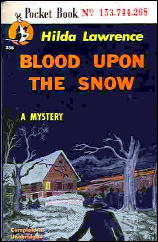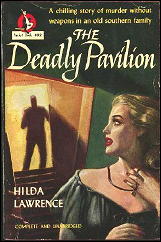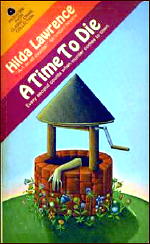Wed 21 Jul 2010
A 1001 MIDNIGHTS review: HILDA LAWRENCE – Blood Upon the Snow.
Posted by Steve under 1001 Midnights , Reviews[4] Comments
by Marcia Muller:

HILDA LAWRENCE – Blood Upon the Snow. Simon & Schuster, hardcover, 1944. Hardcover reprint: Detective Book Club, 3-in-1 edition: February 1945. Reprint paperbacks: Pocket 336, February 1946; Avon Classic Crime PN320, 1970.
Hilda Lawrence wrote three novels featuring the odd investigative trio of private eye Mark East and spinster sleuths Bessie Petty and Beulah Pond. In addition, she published a melodramatic suspense novel, The Pavilion (1949), and two novellas, “Death Has Four Hands” and “This Bleeding House” (both 1950).
She is best known for the East/Petty/Pond books, and for good reason: They present an interesting juxtaposition of the hard-boiled school versus the little-old-lady sleuth, between the customs and mores of Manhattan and those of a small New England village.

The characters are well drawn, the setting evocative, and the interplay between Mark East and his elderly “Watsons” is entertaining.
As this first entry in the series opens, the snow is falling and Mark is arriving at the village of Crestwood. His introduction to Beulah Pond occurs when he stops to ask directions to the house where a prospective client expects him.
When he eventually arrives, he is told he must wait until morning for his interview; and when he meets with Mr. Stoneman, the old man seems to think he is hiring a private secretary rather than a private detective. Mark, however, senses something is very wrong in the house; the old man seems frightened and has a hurt wrist and bruises on his face.

He agrees to stay on for a few days, assuming secretarial duties, and makes it his first order of business to revisit Miss Pond, whom he perceives — rightly so — as a woman who knows a great deal about what goes on in the village.
When he arrives at her home, he is introduced to Bessie Petty, and the unlikely partnership in detection is launched.
The story that follows is one of slowly rising terror. The people with whom Stoneman is staying, Laura and Jim Morey and their two children, also seem disturbed; Stoneman is reported to have been sleepwalking; the housekeeper, Mrs. Lacey, has handed in her notice and seems upset about this; strange mischief has occurred in the wine cellar; and as the black winter night closes in, Mark remembers something Mrs. Lacey said about this being “good soil for evil.”
A slow-paced but absorbing chiller, as are the other two in the series — A Time to Die (1945) and Death of a Doll (1947).
———
Reprinted with permission from 1001 Midnights, edited by Bill Pronzini & Marcia Muller and published by The Battered Silicon Dispatch Box, 2007. Copyright © 1986, 2007 by the Pronzini-Muller Family Trust.
July 21st, 2010 at 5:41 am
For more on the author check out Nick Kimber’s piece “Hilda Lawrence” in Geoff Bradley’s CADS 58.
July 21st, 2010 at 4:58 pm
Thanks, Jeff.
That’s the problem with sitting here at the computer and assuming that everything you want to know is online.
It isn’t. Not everything.
Unfortunately it will be a while before I find where I stashed that particular issue. It’s a recent one, so maybe it won’t take long.
But if in the meantime you, Jeff, or anyone, has access to it and can send me a short version of what it might say about Hilda Lawrence, I’d appreciate it.
— Steve
July 21st, 2010 at 5:46 pm
I believe it was the latest issue so maybe it won’t be too hard to find.
July 21st, 2010 at 6:38 pm
You’re right, and that made it easy to find. It arrived shortly before my brother’s visit a couple of weekends ago, and in the midst of a flurry of cleaning the living room, it got deposited elsewhere and I’d never finished reading it.
All of which is a small prologue to the fact that not much else is learned about Hilda Lawrence personally, other than what I’d come up with earlier and submitted as Comment #4 following Bill Deeck’s review of DEATH OF A DOLL:
https://mysteryfile.com/blog/?p=2568#comments
Nick Kimber does add that she wrote for the Rudy Vallee radio show, and while he admits that “her career as a detective story writer was short lived,” he offers no explanation as to why.
But the article is very much worth reading for the in depth discussion Kimber does of each of Hilda Lawrence’s books and short stories. Wish I might have read it before posting Bill Deeck’s review here, but better late than never.
Now on to the rest of the issue, rudely interrupted.